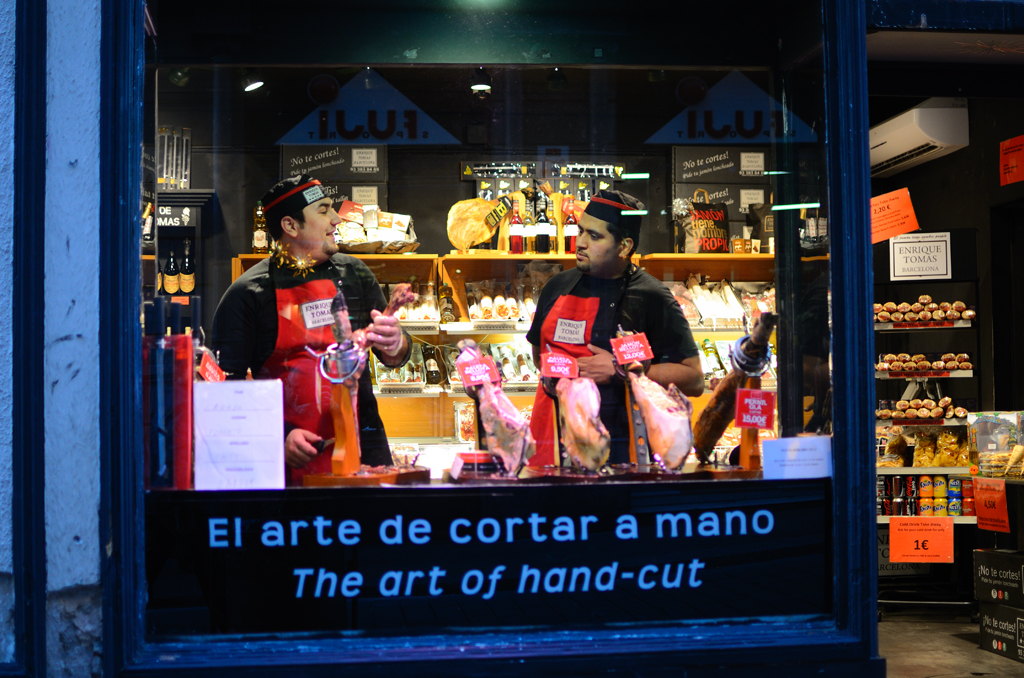Carving Spanish ham is an art more difficult to master than it looks. It's not just about slicing any odd way. It requires skill and the right tools. I cannot teach you to carve it like a specialist but more or less you grab the basics when you've had good instructors and you've carved a ham or two to the bone. It is important to have a very sharp ham knife, which has a long and narrow blade and you should fix the piece in a ham holder, some sort of wooden framework with screws to secure both the wide end and the hoof. You start your cut from hoof to tip, that is from the upper raised part of the ham towards the bottom, first eliminating the thick fat but keeping the first slice of fat that you use to cover the ham meat when you finish. The very fat helps preserving the ham from drying and losing its quality. Beware you don't cut yourself. Keep your fingers off the direction of your knife's cut. It happens sometimes that it slips and you end up hurting the hand that is holding the ham. The slices should be as thin as possible and that is the difficult part. Try not to make a deep curve while you cut. The idea is to keep it flat and to cut thin. It doesn't matter if it takes longer for you and people clean up the dish before you finish serving the slices. That is normal! It happens all the time. Not everyone has the patience to go for the thinner slices and the nice presentation. The final result is definitely better. The shop in the picture is located in Barri Gotic, Barcelona, I think that it was at Plaça Sant Jaume.
Barcelona photos: Daily photographs of Barcelona, Spain. Pictures of a modern city with travel tips in a personal photoblog. A photography and travel site. Art, architecture, people and traditions. Travel to Barcelona through my camera, know more about our city and towns nearby. Welcome!
Wanna be featured?
Showing posts with label ham. Show all posts
Showing posts with label ham. Show all posts
March 06, 2013
October 02, 2008
Jamon Serrano Tastes Better At The Source
![Jamon Serrano Tastes Better At The Source [enlarge]](https://i63.photobucket.com/albums/h135/carloslorenzo/Jamon--.jpg)
One of the most representative Spanish products is jamón serrano (cured ham). Like any other traditional product, serrano ham's quality may vary according to many factors, the breeding farm conditions, the swine diet or the curing process. The same happens with cheese for example (exclude the pig). It is not the same to buy an imported Italian cheese than to go and visit the town where it was made and try it on site. First of all, there it will be cheaper and you would get a higher quality product. So the same story applies to our cured serrano ham, even for us inside the Spanish market. It is not the same to buy a Jabugo serrano leg at La Boqueria market (today's picture is taken there although it doesn't seem to be Jabugo) than to visit Jabugo town in Huelva mountains. I know what I am talking about, because I've done it myself. Of course you can buy one here for Christmas at a higher price, but you know in your heart that the leg you are buying may not be as good although it carried the Jabugo stamp on it. The same happens with olive oil. When on holidays I buy olive oil in Candon, Huelva or Priego, Córdoba. I can find similar stuff sometimes in El Corte Inglés shopping center, but my tongue tells me it is not the same. I don't know, maybe it is due to storage problems, transportation, hot weather, intermediaries, lower quality lots destined to major dealers, who knows. The point is, jamon serrano tastes better at the source (not the pig farm of course). Besides there's the external factor, the good beer, the nice weather, the tapas and the friendly people who cuts it for you. Even in Jabugo or any other town famous for selling good products, you can fall in the typical tourist trap and buy to the wrong stuff. Where am I getting at? Well, what I mean is that quality can be lost along the way and that you'd better visit those local markets to find cheap gourmet delicacies, Spain is still full of them. Visit them before they disappear forever.
Recommended readings:
Recommended readings:
Subscribe to:
Posts (Atom)
Labels
architecture
(164)
modernisme
(81)
gaudi
(74)
art nouveau
(73)
food
(67)
flowers
(63)
street artist
(55)
sculpture
(48)
barri gotic
(39)
las ramblas
(39)
sagrada familia
(33)
dancers
(29)
beach
(28)
amusement park
(27)
port
(27)
human statue
(26)
art
(25)
mosaic
(25)
tibidabo
(25)
guell
(23)
barcelona streets
(22)
sant pau
(22)
tips
(22)
Catalan traditions
(21)
barcelona shop
(21)
market
(21)
montjuic
(21)
gothic quarter
(19)
la boqueria market
(18)
opinion
(18)
carnival
(17)
costa brava
(17)
domenech i montaner
(17)
christmas
(16)
ciutadella
(16)
maremagnum
(16)
folklore
(15)
classic
(14)
balcony
(13)
modernist
(13)
sea
(13)
street art
(13)
barcelona hotels
(12)
catalan art nouveau
(12)
catalan towns
(12)
costumes
(12)
graffiti
(12)
la pedrera
(12)
stained glass
(12)
casa mila
(11)
casa modernista
(11)
door
(11)
fountain
(11)
history
(11)
barcelona market
(10)
ceiling
(10)
la rambla
(10)
barcelona port
(9)
bikes
(9)
chocolate
(9)
crafts
(9)
paper mache
(9)
pedralbes
(9)
port aventura
(9)
vintage
(9)
architects
(8)
cosmocaixa
(8)
harbor
(8)
hotel
(8)
motorbike
(8)
passeig de gracia
(8)
arc de triomf
(7)
classic cars
(7)
dali
(7)
gracia
(4)
palau de la musica
(4)
accommodation
(3)
barcelona bar
(3)
casa batllo
(2)
cheese
(2)
cruises
(2)
gracia quarter
(2)
ham
(2)
wine
(2)
hostel
(1)
parc guell
(1)
picasso
(1)
